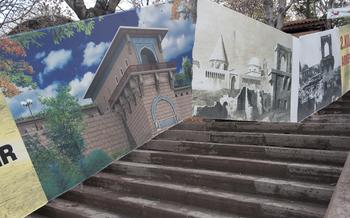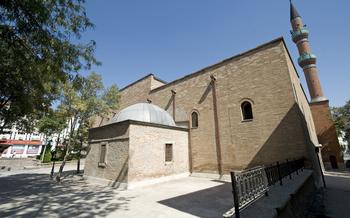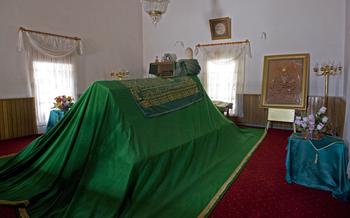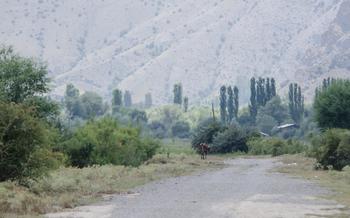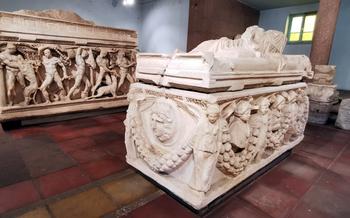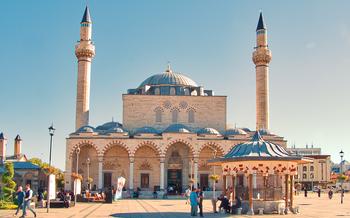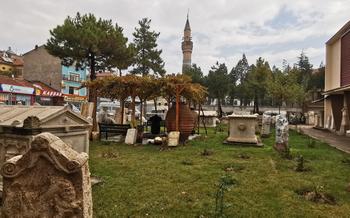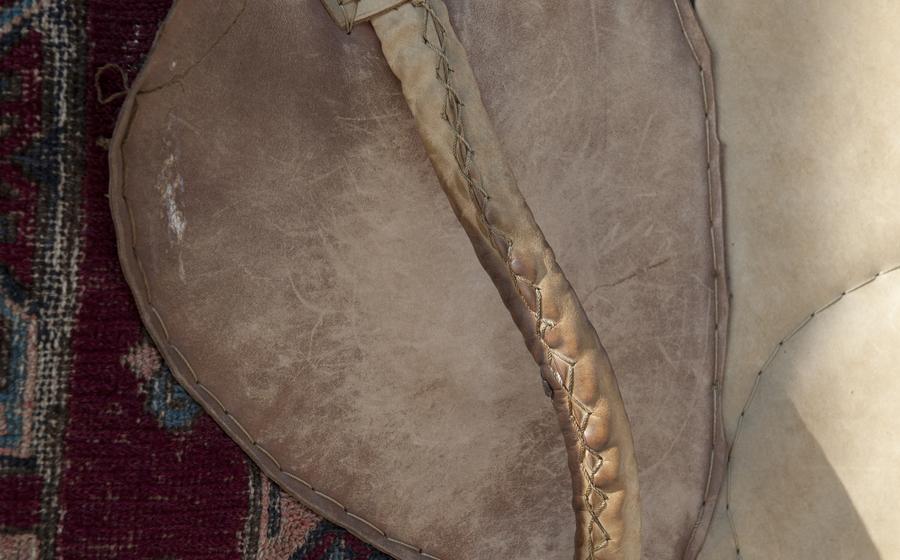
Selimiye Mosque
- The Brainchild of the Brilliant Architect Sinan
- Exploring the Mosque's Exterior
- Marveling at the Interior
- Admiring the Calligraphic Masterpieces
- Experiencing the Call to Prayer
- Unveiling the History Museum
- Attending a Religious Ceremony
- Discovering the Whirling Dervishes
- Unveiling Konya's Culinary Delights
- Exploring the City's Historic Sites
- Embracing the Local Culture
- Shopping for Souvenirs
- Insider Tip: Unveiling Konya's Cultural Essence through the Mevlana Festival
The Brainchild of the Brilliant Architect Sinan
The Selimiye Mosque stands as a testament to the genius of Mimar Sinan, the legendary Ottoman architect who designed and oversaw its construction. Sinan, a prolific master, left an indelible mark on Ottoman architecture, creating iconic structures that continue to inspire awe centuries later. His innovative designs and engineering prowess revolutionized mosque architecture, and the Selimiye Mosque is widely regarded as his magnum opus.
Sinan's approach to architecture was deeply rooted in both tradition and innovation. He meticulously studied Byzantine and earlier Islamic architectural styles, incorporating their elements into his own designs while pushing the boundaries of what was possible. In the Selimiye Mosque, he showcased his mastery of geometry and acoustics, creating a harmonious and awe-inspiring space.
The mosque's grand dome, reaching a height of 43 meters, is a testament to Sinan's engineering genius. Its graceful curves and intricate patterns create a sense of lightness and elegance, belying its massive size. The four slender minarets, each adorned with three balconies, rise majestically from the corners of the mosque, adding to its visual grandeur.
Sinan's attention to detail is evident in every corner of the mosque. From the intricate stone carvings adorning the façade to the delicate floral motifs on the interior walls, every element contributes to the mosque's overall beauty and harmony. The Selimiye Mosque remains a testament to Sinan's brilliance, a masterpiece that continues to inspire and enchant visitors from around the world.
Exploring the Mosque's Exterior
The exterior of the Selimiye Mosque is a testament to the grandeur and artistry of Ottoman architecture. The imposing façade, adorned with intricate stone carvings and decorative tiles, captivates the eye. The majestic domes and minarets soar high into the sky, creating a breathtaking skyline that dominates the city's landscape. The intricate stone carvings showcase scenes from the Quran and Islamic history, while the decorative tiles add a vibrant splash of color to the mosque's exterior. The calligraphy adorning the mosque's façade is a testament to the skill and artistry of Ottoman calligraphers, showcasing verses from the Quran in beautiful and intricate script.
Marveling at the Interior
Venturing into the mosque's vast prayer hall, one is immediately struck by its sheer size and grandeur. The high ceiling, supported by an array of columns, creates a sense of spaciousness that is both awe-inspiring and serene. The intricate mihrab, a niche indicating the direction of Mecca, is a masterpiece of Islamic craftsmanship, adorned with colorful tiles and delicate carvings. The minbar, the pulpit from which the imam delivers sermons, is equally impressive, featuring intricate woodwork and inlaid mother-of-pearl.
The interior of the mosque is illuminated by a multitude of dazzling chandeliers, casting a warm and inviting glow. These chandeliers, with their intricate designs and crystal embellishments, are works of art in their own right, adding to the overall splendor of the mosque's interior.
The floor is covered in soft and vibrant carpets, creating a sense of warmth and comfort. The carpets are adorned with intricate patterns and motifs, reflecting the rich artistic traditions of the Ottoman Empire. The walls of the mosque are decorated with exquisite tiles, featuring geometric patterns, floral motifs, and verses from the Quran. These tiles are a testament to the skill and artistry of the Ottoman craftsmen who created them.
Overall, the interior of the Selimiye Mosque is a breathtaking display of Islamic architecture, showcasing the finest craftsmanship and artistry of the Ottoman Empire. It is a space that inspires awe, tranquility, and a deep appreciation for the Islamic faith.
Admiring the Calligraphic Masterpieces
The walls of the Selimiye Mosque are adorned with intricate calligraphy, showcasing the artistic prowess of Ottoman calligraphers. Verses from the Quran, the holy book of Islam, are meticulously inscribed in gold and blue paint, creating a visually stunning display. The calligraphy serves not only as a decorative element but also as a reminder of the mosque's religious significance and the importance of the Quran in Islamic culture.
The calligraphers who created these masterpieces were highly skilled artisans, trained in the traditional Islamic art form. Their work demonstrates a deep understanding of Arabic script and the ability to transform it into a form of visual expression. The intricate patterns and flourishes add a touch of elegance and grandeur to the mosque's interior, enhancing its overall beauty and spiritual atmosphere.
The calligraphy in the Selimiye Mosque is not merely decorative; it also serves an educational and didactic purpose. The verses from the Quran inscribed on the walls provide guidance and inspiration to visitors, reminding them of the teachings of Islam and encouraging them to reflect on their spiritual lives. The calligraphy thus becomes a powerful tool for disseminating Islamic knowledge and promoting spiritual contemplation.
Experiencing the Call to Prayer
As the sun descends, casting a warm glow upon the city, the muezzin's voice reverberates through the air, summoning the faithful to prayer. The melodious chant, echoing from the Selimiye Mosque's minarets, weaves its way through the bustling streets, inviting all within earshot to partake in this sacred Islamic tradition.
The faithful, heeding the call, emerge from their homes and workplaces, their footsteps creating a rhythmic symphony as they converge towards the mosque. A palpable sense of serenity descends upon the city as the muezzin's voice continues its melodic journey, transcending religious boundaries and touching the hearts of all who listen.
For those fortunate enough to witness this spectacle, it is a mesmerizing experience, a testament to the enduring power of faith and the beauty of Islamic tradition. The call to prayer serves as a reminder of the spiritual essence that permeates the city of Konya, inviting visitors to delve deeper into the rich religious heritage that shapes its identity.
Unveiling the History Museum
Within the sacred confines of the Selimiye Mosque complex lies a treasure trove of history, waiting to be uncovered. The History Museum, housed within the mosque's walls, invites visitors to embark on a journey through time, shedding light on the mosque's rich past and significance.
The museum's collection boasts a diverse array of artifacts, each narrating a chapter in the mosque's story. From ancient manuscripts and architectural models to relics and inscriptions, the museum offers a tangible connection to the mosque's construction, evolution, and cultural impact.
Visitors can marvel at the intricate details of the mosque's original design, as revealed in meticulously crafted models. They can pore over ancient manuscripts, deciphering the words of scholars and chroniclers who witnessed the mosque's grandeur. And they can examine relics that have survived the passage of centuries, providing a glimpse into the daily life of the mosque's congregation.
The History Museum is not merely a repository of artifacts but a living testament to the enduring legacy of the Selimiye Mosque. Through its exhibits, it invites visitors to delve deeper into the mosque's history, appreciate its architectural brilliance, and gain a profound understanding of its role in shaping Islamic architecture and culture.
Attending a Religious Ceremony
Konya, a city deeply rooted in Islamic traditions, offers visitors a unique opportunity to witness religious ceremonies and immerse themselves in the spiritual practices of Turkey. The Selimiye Mosque, with its grandeur and historical significance, serves as a prime location to experience these sacred rituals.
Participating in prayers or festivals held within the mosque allows one to connect with the local Muslim community and gain insights into their religious practices. The call to prayer, echoing through the city, invites the faithful to gather for congregational prayers. Observing these rituals provides a glimpse into the devotion and spirituality that permeate Turkish society.
Attending a religious ceremony at the Selimiye Mosque is not only a chance to witness Islamic traditions but also a profound cultural experience. It offers a deeper understanding of the role of religion in Turkish society and the significance of the mosque as a center of community life.
Discovering the Whirling Dervishes
Konya holds a special place in the history of Islam as the birthplace of the Mevlana Order, founded by the renowned Sufi mystic Mevlana Celaleddin Rumi. The Mevlevi Order is known for its unique form of worship, the Sama, a mystical dance performed by whirling dervishes. The Whirling Dervishes, clad in long white robes and iconic felt hats, rotate gracefully to the rhythm of Sufi music, symbolizing their connection to the divine.
Witnessing a Sama performance is a mesmerizing experience that transports visitors to a realm of spirituality and tranquility. The dervishes' movements, accompanied by haunting music, create a vortex of energy that draws spectators into a state of profound meditation. The Mevlana Museum, located in the heart of Konya, offers visitors a glimpse into the life and teachings of Mevlana Rumi and the history of the Mevlevi Order. Here, one can explore exhibits showcasing manuscripts, artifacts, and personal belongings of the great Sufi master.
By delving into the world of the Whirling Dervishes, travelers gain a deeper understanding of the Sufi tradition of Islam, which emphasizes love, tolerance, and unity. Konya, with its rich cultural heritage and spiritual significance, invites visitors to embark on a journey of self-discovery and enlightenment.
Unveiling Konya's Culinary Delights
Konya is a culinary paradise, offering a diverse range of traditional Turkish dishes that tantalize the taste buds. Etli ekmek, a delicious flatbread topped with minced meat, is a must-try. Tirit, a hearty stew with shredded meat and bread, is another local specialty that is sure to satisfy.
The city's vibrant markets are a treasure trove of fresh produce, herbs, and spices, where one can witness the lively interactions of local traders and shoppers. Bargaining is a common practice, and visitors can enjoy the thrill of securing the best deals on fresh fruits, vegetables, and other local delicacies.
Konya's rich culinary heritage is a testament to the city's diverse cultural influences. From traditional Turkish cuisine to international flavors, there is something to satisfy every palate. Don't miss the opportunity to savor the delectable delights that Konya has to offer.
Exploring the City's Historic Sites
While in Konya, embrace the opportunity to delve into its rich history and cultural heritage by visiting its notable landmarks. The Alaeddin Mosque, constructed in the 12th century, is a magnificent example of Seljuk architecture, showcasing intricate carvings and awe-inspiring tilework. Step into the Sille Village, an ancient settlement located just outside the city, to witness fascinating rock-cut dwellings, churches, and mosques, offering a glimpse into the region's diverse past. The Konya Archaeological Museum houses an impressive collection of artifacts unearthed from various archaeological sites in the province, providing insights into the region's ancient civilizations. Through these explorations, uncover the layers of history that have shaped Konya into the vibrant city it is today.
Embracing the Local Culture
Immerse yourself in the vibrant local culture of Konya by interacting with its friendly and welcoming people. Experience the warmth of Turkish hospitality as you engage in conversations with locals, learning about their traditions and way of life. Attend cultural events and festivals to witness the city's rich artistic heritage, from traditional dance performances to musical concerts. These events provide a unique opportunity to immerse yourself in the rhythm of Konya's cultural heartbeat. Embrace the local lifestyle by visiting traditional Turkish markets, where you can haggle for unique souvenirs and handicrafts while supporting local artisans. Take home a piece of Konya's charm that will serve as a lasting reminder of your journey.
Shopping for Souvenirs
Konya offers a vibrant shopping scene with bustling bazaars and charming shops. Indulge in the art of bargaining at the local bazaars, where you can find an array of unique handicrafts, souvenirs, and traditional Turkish delights. Discover intricate carpets, hand-painted ceramics, and gleaming copperware that showcase the skill of local artisans. Support the local economy and take home a piece of Konya's charm. Whether you seek exquisite jewelry, aromatic spices, or colorful textiles, Konya's markets offer a treasure trove of unique items to cherish.
Insider Tip: Unveiling Konya's Cultural Essence through the Mevlana Festival
Immerse yourself in the heart of Konya's cultural heritage by planning your visit coinciding with the Mevlana Festival, held annually from December 17th to December 19th. This vibrant festival celebrates the life and teachings of Rumi, a renowned Sufi mystic and poet who called Konya his home. During this enchanting event, the city comes alive with a kaleidoscope of colors, music, and performances, offering an unforgettable experience.
Witness the mesmerizing Sama, a traditional whirling dervish ceremony, where dancers gracefully rotate to the rhythm of Sufi music, representing their spiritual journey towards enlightenment. Explore the Mevlana Museum, a treasure trove of artifacts, manuscripts, and personal belongings of Rumi, providing insights into his life and philosophy. Participate in cultural workshops, exhibitions, and conferences that delve into the rich history and traditions of Konya.
Indulge in the flavors of Turkish cuisine at food stalls offering a tantalizing array of local delicacies. Experience the warmth and hospitality of the Konya people as they welcome visitors with open arms. With its captivating atmosphere and profound cultural significance, the Mevlana Festival is an extraordinary opportunity to immerse yourself in the essence of Konya and discover the profound teachings of Rumi, leaving an indelible mark on your soul.
